How many schoolchildren over the decades glanced above the doorway to see a woman reading to a boy while a girl nearby is working on an abacus? It is a simple, beautifully sculpted panel, attentive to detail, as the architectural historian William Rhoads writes, “down to the shoelaces.” The scene is one of two on the carved stone panels on the Marlboro Middle School in the Hudson Valley, an Art Deco-style school completed in 1937. Today’s school buildings are far smarter, in using energy efficiently and caring more for the environment, but they aren’t as full of the wisdom of storytelling in their exterior design. In those historic panels, the designers imparted the value of learning.
Like the reliefs of the Marlboro school, the architectural panels of another Art Deco-style structure, at 20 Exchange Place in Lower Manhattan, hearken to know-how. They, too, tell stories intended to elevate mankind, in this instance on the exterior of a major bank. Although City Bank Farmers Trust Company had to scale back its ambitious plans to be the “world’s tallest” skyscraper when the Great Depression ravaged the economy, the bank still invested much in the exterior’s decorative elements that look not only to the present but to other eras for meaning. The building’s splendid, ornate doorways exemplify this best, showing both historic means of transportation, like sailing ships, and the newest of that era, in airplanes.
At the core of both, as in so many panels on these Art Deco structures, is the value of human progress and discovery, whether it’s in the technology advancement of the present or the wisdom of ancient cultures. The buildings imparted this value and saluted ingenuity and learning, a sort of stubborn optimism in the midst of a society seeking to emerge from the Great Depression. (For Part I of Mindfulwalker.com’s exploration of these reliefs, see “Symbol and Story in Art Deco Panels.”)
Here’s the exquisite panels on these two buildings.
Marlboro Middle School, Marlboro, N.Y.
Originally the Marlborough Central High School and Grade School, the current middle school has been “insensitively altered” over the decades, as architectural historian Rhoads observes. The sculptural panels are on an Art Deco structure that Gerard Betz designed. Betz was a Hudson Valley architect whose designs during the 20th century encompassed a wide variety of styles. The school, built in 1936-1937, was a project of a New Deal program, the federal Public Works Administration (PWA). Despite the various alterations to the school over nearly eight decades, the sculptural panels of stone, fortunately, have survived. Each doesn’t stand out to a passerby, but they are worth a close-up look.
The panels can be read for what they seek to convey and what they tell us about the 1930s. They’re historic artifacts of a society seeking uplift, both economically and philosophically, in the years following the Great Depression. They also express the timeless virtues of wisdom and learning. The WPA/Federal Art Project likely commissioned the reliefs, according to Rhoads. They reflect the frequent efforts of WPA art on school buildings to inspire and to hearken to the progress of human civilization – in essence, to hold up the worth of education at a time when society had come apart at the seams.
In the first panel, a woman reads to a young boy, whose upright posture seems to signal a respect for and intent to listen well to what the woman is reading. Nearby, a girl sits in front of and works on an abacus, the ancient counting tool still in use in the 1930s and today in some schools’ programs and activities. The relief’s symbols reinforce the worth of learning, from a book and globe to a large owl radiating the light of wisdom.
A close-up of the owl, signifying wisdom and enlightenment
The theme of the other Art Deco reliefs signify history and learning. A woman reads an ancient scroll. Nearby, a figure that appears to represent beauty, in her flowing robe and headdress, gazes into a mirror. They’re flanked by an urn with a profuse mound of flowers and a tree with abundant leaves.
The reflection of learning through the ages in the reading of a scroll
20 Exchange Place, New York
Like the worlds of learning that the Marlboro school heralded, the sculpture of the Art Deco decoration on 20 Exchange Place invoked the how far progress could take humanity. However, the bank that constructed the skyscraper, which is now high-end apartment rentals, had to limit its horizons somewhat during the drawing board phase. When City Bank Farmers Trust filed plans for the building in October, 1929, the bank dove into the competition to build the “world’s tallest” skyscraper with one it claimed would earn that title.
No one, however, planned on the massive stock market crash, which killed a proposed merger with another financial institution, the Corn Exchange Bank. At the time, it would have created the world’s wealthiest bank, according to the landmark designation of the New York City Landmarks Preservation Commission. When the merger disintegrated, City Bank Farmers Trust scaled back in size.
Still, the 59-story skyscraper completed in 1931 and designed by the high-profile firm of Cross & Cross, two brothers, didn’t lack for the reaches of imagination and ambition in the Art Deco ornamentation, with its carved abstract forms, allegorical figures, and symbols of optimism. In the midst of the Great Depression, City Bank Farmers Trust went all-out in the building’s exterior of granite and limestone and interior lobbies of marble.
Most evocative of the bank’s intention to celebrate human potential and achievement are the sculpted Art Deco doorway panels of nickel silver. The storytelling is one of “this is where we came from” and “this is where we’re heading” by showing various modes of transportation. The reliefs capture in striking detail steam locomotives and sailing ships, as well as the new, daring means of travel and exploration of the early 20th century, airplanes and ocean liners. An international bank, to be sure, wanted to be seen as embracing this world of possibility.
Imagine how more buildings of today would be enlivening, even inspirational, if their exteriors told of 21th century advancements and discoveries. At least these survive, from an era that considered it important to honor the milestones in the carvings and murals of its buildings.
Part I: In Part I, Mindfulwalker.com focused on the ancient meanings and modern symbols found on the panels of two other Art Deco buildings, one in New York and one in Pittsburgh.
References and Further Exploration
William B. Rhoads, Ulster County, New York: The Architectural History & Guide, 2011.
Art Deco Buildings
The beauty of Art Deco structures around the world, illustrated with David Thompson’s photographs
On Mindfulwalker.com
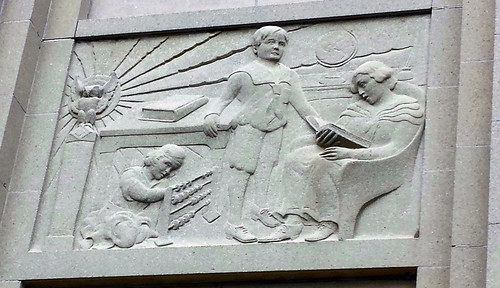
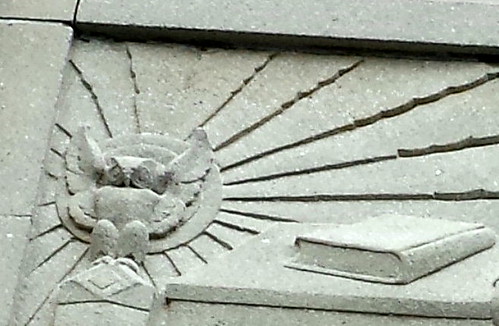
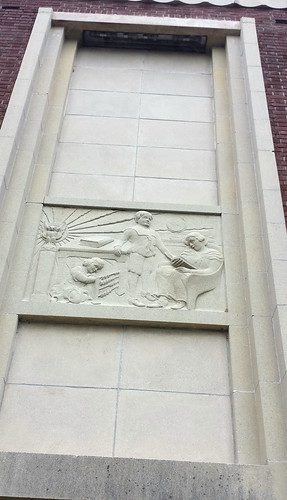
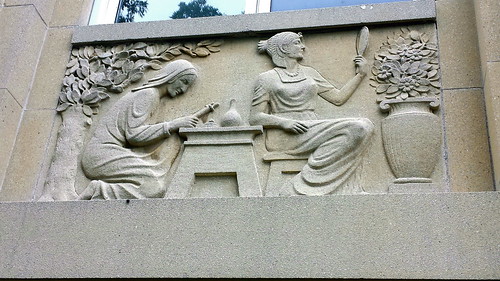
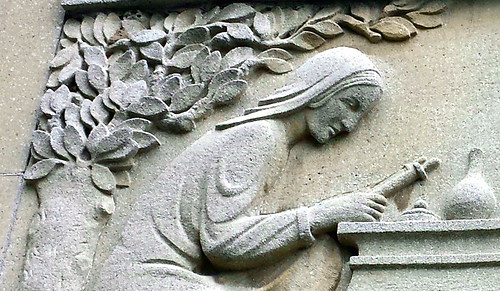
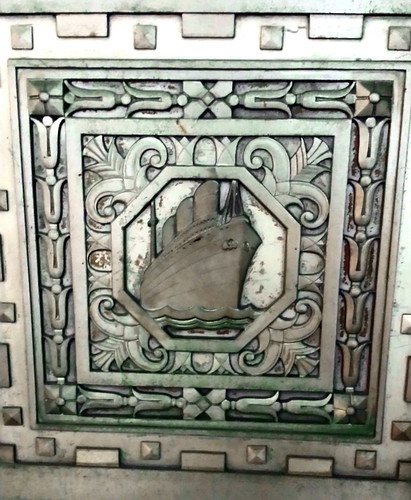
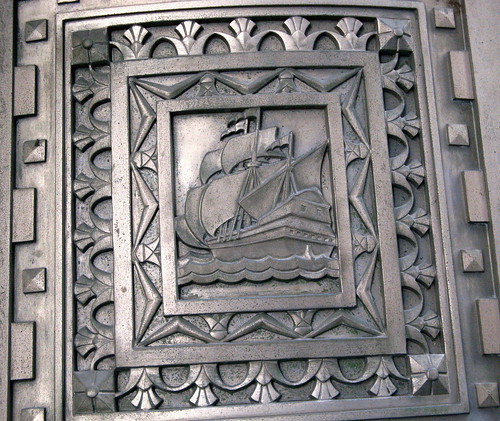
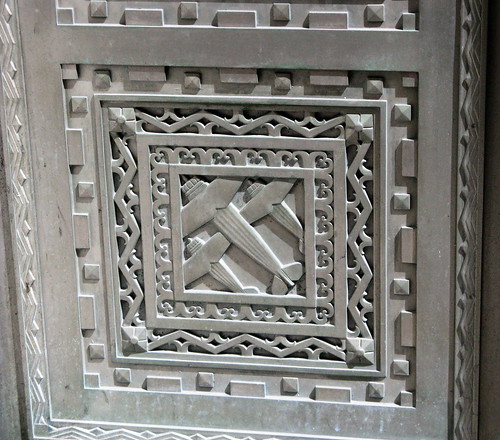



Love the phrase ‘stubborn optimism’. Agree that there is little on the facades of many contemporary buildings that tell a story of any kind.
Janet,
We need some of that “stubborn optimism” in this age. Thank you so much.
Also, I know that you are very observant about architecture and buildings, and their composition and stories, so it is affirming that you share this opinion of contemporary facades. I want to be sure I’m not being narrow-minded about them.
Gratefully,
Susan
I am familiar with the Marlboro panels from when I was little. I realized just a few years ago how much of my (well-hidden) optimism about society was based in WPA-style public art.
I was trying to explain to Em back then why I had grown up believing in the U.N. I realized it was because of the architecture (I am also unashamedly a fan of Brasilia). As a child, I associated the architecture and public art with good, shining, strong Society. When I see that art today, I still feel that “stubborn optimism,” although I have become cynical. You’re right, Susan – this art is ever more relevant.
Caryn,
I always learn something from your insights and experiences of architecture. What qualities in the U.N. headquarters engender your sense of “good, shining, strong Society”? When I’ve walked on its civic plaza, I’ve often felt how peaceful and civilized is that space, set back from the city’s bustle and yet within it, and so near the East River as to provide an expansive view of the river and the boroughs across from Manhattan.
While I’ve known the basic approach for the U.N structures, I didn’t know the exact process of the international group of architects that led to the design. So I poked around and found a very good article that illuminates the process.
The ArchDaily article observes that, for the 39-story tower, “the International Style aesthetic was an intentional decision by [Oscar] Niemeyer and the rest of the collaborating architects as a way in which to symbolize change that embodies a sense of `newness’ that sheds light on the optimistic future of the world’s nations working together as one collective body rather than the disparate warring units of the past.” Ah, the hope!
It’s wonderful that you are familiar with the Marlboro panels. Did those images mean anything to you as a child? I still recall how statues around school buildings made an impression on me.
Thanks so much!
Susan